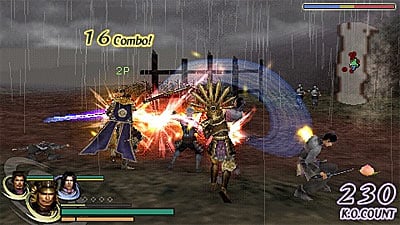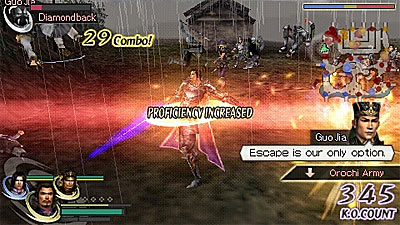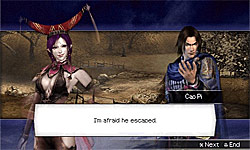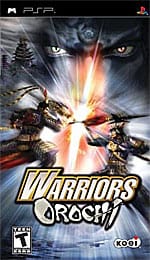The Smaller It Gets,
The Better It Gets
Warriors Orochi is certainly as good a hack-and-slash game as you can expect to find on a handheld. The game was originally available for the PS2 and the X360 last year, and although it didn’t exactly set the world on fire, it secured its position alongside such luminaries as the Samurai and Dynasty Warrior series.

Sure we all know how redundant the hack-and-slash genre of games can be, and that’s why we don’t expect a hell of a lot out of it. Following a simple formula of mowing down scores of enemies with various lethal weapons and special attacks are its prime directives – and thou shalt not stray far from the path. The weapons represent the time period, consisting of various swords, axes, maces, and spears. Considering that the PSP has a much smaller screen than what you would use to view your console, the enemy hordes have been scaled back to fit the screen. It would be virtually impossible to keep a visual on your character otherwise. Less onscreen enemies actually makes the game seem more realistic not necessarily more challenging, since they drop like flies with a simple swipe of your weapons.
In an interesting concept that includes characters from both Samurai and Dynasty Warriors, both parties are compelled to fight against each other and eventually unite against a common threat. That threat is the magical demon Orochi. Using his dark powers, he has combined all feudal kingdoms of China and Japan into warring factions, turning this into the mother of all wars. And that’s about it for the storyline. Don’t expect any plot twists or character development. Once the premise is set, it’s all about fighting. Unlike the other Warrior series, Warriors Orochi is not entirely concerned with even feigning historical accuracy or realism. This game is pure fantasy and makes no bones about it. Not that Samurai or Dynasty are any more believable.

You begin with a small clan and eventually amass an army. Throughout the game you are fighting enemies for the ultimate cause of freeing captured warriors and defeating Orochi and his army of Hell spawns. You will make friends that accompany you in battle. While there are different class systems and different attributes associated with various warriors such as power, tech, or speed, they all play so similarly that it’s difficult to tell them apart. There are three basic methods of attack including Normal, Charge, and Musou. The Musou is a screen-clearing attack, and the most powerful. The drawback is that it takes a while to charge, which will leave you temporarily vulnerable. Most of your hacking and slashing entertainment will be facilitated by a manic mashing of the action button. Combos will be created automatically, but using the Charge attack at the end of them will increase your devastation.
Three characters can be taken into battle and switched at any time. As I mentioned, the characters are very similar so there’s no real advantage to using different ones in terms of different attributes, but you can take advantage of the Musou attacks by combing them for extra power attacks or allowing time to charge while another character takes on the hordes. There are 77 different warriors available, from which you can make almost unlimited combinations of three. Koei only hints at the depth that could have been exploited if each character did have measurably different attributes. The gameplay depth of just combining characters alone would be insane, not to mention the replay value. Unfortunately the only real differences are visual.

Weapons are customizable, as are each character’s attributes, although it’s virtually impossible to discern much difference with the characters. Having said that, it’s even difficult to discern upgrades with the weapons, except for various elemental attacks that you can actually see, such as fire, ice, and magical energy. Weapons can be acquired from enemies on the battlefield. Using growth points, you can increase weapon attributes such as base attack and increase the number of slots for further upgrading. Various weapons can also be combined, as they become fused hybrids. Upgrades such as more powerful attacks and an increase in range are largely overshadowed by the relatively easy gameplay. Remember, this is a simple button masher. As long as you’re tapping that button and moving around in the right direction, you won’t experience much trouble.

The environments are impressive for their sheer scale, but certainly not for the graphic quality. The maps lack detail. In most cases the battlefield is little more than a field. Occasionally there will be some buildings and a line that represents a road. But we are not here to enjoy the scenery, we are here to fight, and the game really does concentrate on that aspect. We can move about the spacious maps with no loads as we move from section to section. There is some slowdown, but considering how busy the game is, I’m surprised there isn’t more. But that surprise is short lived because it’s very noticeable in the two-player, ad hoc mode. It doesn’t make this mode unplayable, but it does raise suspicions concerning the overall lack of production values.
Unlike the console version, there are no cutscenes. The music is good, but it’s generic and a little too “happy” for a game of this style. As expected, the voiceacting is just as bad as every other Warriors game in the franchise. It must be some kind of inside-joke with the developers to purposely cultivate such cheesy performances.
Warriors Orochi has some shortcomings, but to be fair I am imposing my personal preference on what the game should, or could be. But it’s not totally my fault for thinking this. This is a simple hack-and-slash game. By its very nature it’s repetitive. By hinting at more depth with weapon upgrades, 79 playable and combinable characters with upgradable attributes, and a two-player mode, I think it’s the developer’s responsibility to fully realize these features and implement them in the gameplay. Otherwise don’t tease us.
RATING OUT OF 5 RATING DESCRIPTION 3.0 Graphics
Good character models, large battlefields, but sparse detail. 4.2 Control
Tight and fast. Perfect button mashing system. 3.2 Music / Sound FX / Voice Acting
Generic happy music, awful voiceovers, good slashing sound effects. 3.0 Play Value
Redundant gameplay. Best in small doses. 3.3 Overall Rating – Fair
Not an average. See Rating legend above for a final score breakdown.
Game Features:
